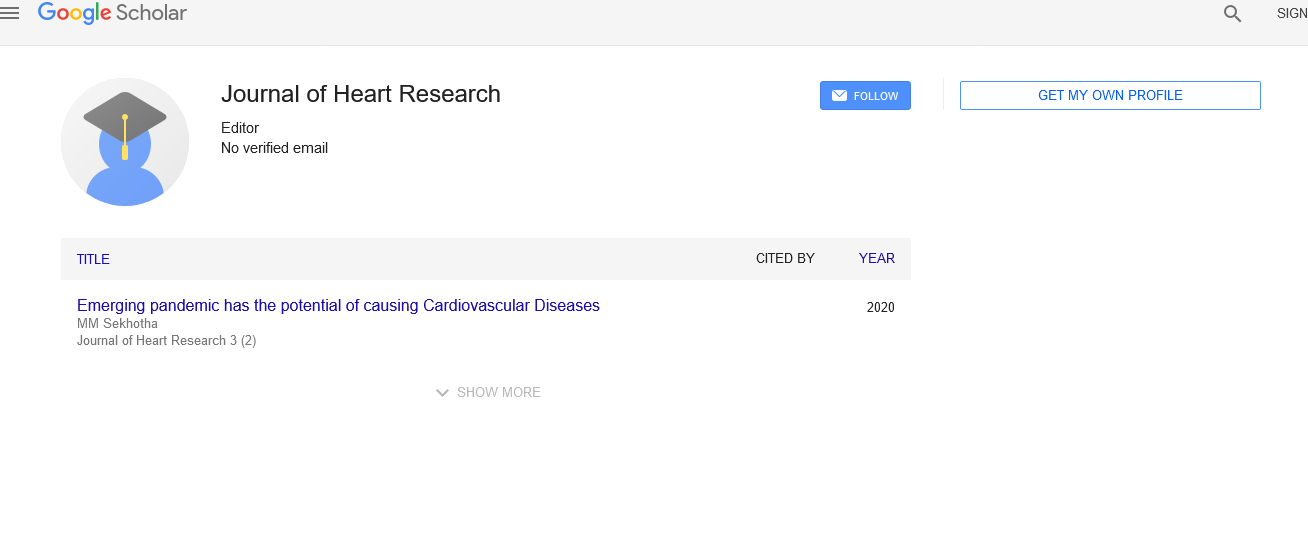PTP1B as a myocardial infarction therapeutic target
Received: 09-Jun-2022, Manuscript No. puljhr-22-5068; Editor assigned: 11-Jun-2022, Pre QC No. puljhr-22-5068 (PQ); Accepted Date: Jun 27, 2022; Reviewed: 23-Jun-2022 QC No. puljhr-22-5068 (Q); Revised: 24-Jun-2022, Manuscript No. puljhr-22-5068 (R); Published: 30-Jun-2022, DOI: 10.37532/puljhr.22.5(3).30-31
Citation: Robinson B. PTP1B as a myocardial infarction therapeutic target. J Heart Res. 2022; 5(3):30-31.
This open-access article is distributed under the terms of the Creative Commons Attribution Non-Commercial License (CC BY-NC) (http://creativecommons.org/licenses/by-nc/4.0/), which permits reuse, distribution and reproduction of the article, provided that the original work is properly cited and the reuse is restricted to noncommercial purposes. For commercial reuse, contact reprints@pulsus.com
Abstract
Biological systems regulate themselves through activation and inactivation cycles, the balance of which is crucial in allowing or suppressing signaling cascades and their downstream effects. Phosphorylation (activation) and dephosphorylation (inactivation) processes govern kinase signaling pathways. Because kinase pathway hyperactivity is a causal and crucial factor in the development of cardiac diseases, the creation of pharmacological inhibitors has been a hot topic of research. Enhancing the activity of inhibited but possibly helpful kinase activities, on the other hand, offers another therapeutic option. Kinase dephosphorylation by phosphatases results in route inactivation and suppression in this circumstance. Inhibiting the inhibitors thus gives a mechanism to boost the activity of specific pathways.
Keywords
Myocardial infarction; Phosphatase inhibitors; PTP1B
Introduction
From transcription, such as mRNA stability and splicing, to translational regulation and protein turnover through degradation, protein kinase activities are regulated at numerous levels. Protein phosphorylation is a major regulatory process that is mediated by protein kinases or receptor tyrosine kinases at the protein level. Kinases are enzymes that catalyze serine/threonine or tyrosine phosphorylation. Kinase activation occurs when critical residues in the active site of the enzyme are phosphorylated, either by auto activation through conformational changes, such as those caused by ligand-receptor tyrosine kinase contact, or by phosphorylation by other kinases.
Outside of the active site region, phosphorylation offers binding sites for downstream targets as well as the transmission of the activation signal. Furthermore, phosphorylation events can change localization, allowing for spatial modulation. Kinases have been demonstrated to mediate a variety of pathways that can result in negative effects in the setting of cardiovascular disease and indeed, every system and disease of the body. As a result, there are numerous kinase potential targets in the clinic for pharmaceutical intervention.
Identifying kinase inhibitors to block pathways that are elevated in the disease state has taken a lot of time and effort. Up-regulating alternative kinase-dependent pathways that are inhibited in disease states, on the other hand, could be beneficial. Finding ways to upregulate the latter has become a more recent emphasis, with phosphatases proving to be a promising target. Phosphatases decrease kinase activity by catalyzing the removal of key phosphate groups, hence dampening activity and suppressing the pathway. Thus, phosphatases are kinase inhibitors, and inhibiting them is a way to use endogenous processes to enhance the activity of important kinases.
PTP1B as a therapeutic target in vascular disease
Activation of protein-tyrosine phosphatase 1B (PTP1B) has been found to diminish signaling through insulin and leptin-dependent pathways – by dephosphorylating and turning off the pathway – and has sparked interest as a possible therapeutic target for up-regulating insulin and leptin signaling. Through a tyrosine kinase receptor regulated by PTP1B, leptin impacts appetite and energy expenditure, while insulin regulates glucose absorption and glycogen formation. Therefore, increasing activity (by inhibiting PTP1B) is expected to allow these signaling pathways to continue, resulting in decreased appetite and increased glucose uptake and glycogen synthesis. This is especially important in the treatment of diabetes and obesity. In these circumstances, insulin resistance is both a significant and causal trait, and improving insulin sensitivity would improve metabolic metrics. Inhibition of PTP1B has been established as a relevant therapeutic strategy as a negative regulator of both leptin and insulin signaling. In mice, knocking down the PTP1B gene boosted insulin and leptin sensitivity and resistance to obesity generated by a high-fat diet. Over the last ten years, pharmacological inhibition of PTP1B utilizing trodusquemine (MSI-1436), a small molecule inhibitor of PTP1B, has been studied in completed Phase I trials for obesity, diabetes, and breast cancer. Inhibition of PTP1B was achieved by down regulation utilizing antisense technology in a small-scale (n=92) Phase II experiment in diabetes. IONISPTP-1BRx improved glycaemic indices and decreased leptin signaling when used in combination with metformin alone or with a sulfonylurea, according to the findings. PTP1B inhibition has been studied in the treatment of diabetes and breast cancer, but there is evidence that it may also be useful in reducing the risk of Myocardial Infarction (MI) by suppressing the formation of atherosclerotic plaques. In a mouse model of atherosclerosis (Low-Density Lipoprotein Receptor Null (LDLR) mice on a high-fat diet), MSI-1436 was used to inhibit PTP1B. The researchers discovered that MSI1436 therapy lowered plaque burden at the end of the study, implying that PTP1B inhibition both prevents and reverses plaque formation. However, it should be noted that reversal of existing plaques has not been proven conclusively, while PTP1B inhibition could undoubtedly slow down formation. Although the scientists were unable to confirm PTP1B inhibition directly, they did find that knocking down PTP1B in macrophages inhibited plaque growth in a different mouse model of atherosclerosis (ApoE deficient mice).
PTP1B inhibition may reduce the incidence of MI in patients with atherosclerosis by delaying plaque progression, according to these tudies. While the results of MSI-1436 in pre-clinical investigations and clinical trials are promising, this molecule has one disadvantage: it is not orally bioavailable. Injections are used to deliver drugs, which is inconvenient for patients who require long-term care. DPM-1001 is a more effective inhibitor of PTP1B than MSI-1436, with an IC50 of 100 nM vs 600 nM for MSI-1436. DPM-1001, like MSI-1436, reduced obesity weight in obese mice in preclinical models of obesity (diet-induced) by 5% over 3-weeks. At the same time, glucose was removed from the bloodstream more quickly, and insulin sensitivity (exogenously given insulin-induced glucose absorption) improved.
PTP1B as a therapeutic target in the heart
These methods may also be useful in the treatment of people who have suffered a Myocardial Infarction (MI). In clinic, PTP1B activity is raised in failing hearts, and suppression of PTP1B by pharmacological or genetic techniques improves cardiac function after a heart attack. PTP1B null mice were protected from cardiac dysfunction after a MI, and pharmacological inhibition with another pharmacological inhibitor, AS279, had similar results. While the extent of the infarct remained same, fibrosis was decreased and heart function was improved. PTP1B suppression in MI was demonstrated to increase angiogenesis in the null model. MSI-1436, a cardiac injury inhibitor that showed no side effects in Phase I trials, improved outcomes in two animal models of heart injury.
Both the caudal (tail) fin and the heart of the zebra fish can regenerate after resection injury (removal of a part of the tissue). MSI-1436 increased the rate of regeneration and cellular proliferation by 2–3 times in both models. Importantly, MSI-1436 was not hazardous to zebra fish eggs or undamaged adult animals, nor did it cause abnormal overgrowth or tissue distortion in regenerated tissues. PTP1B has been demonstrated to influence a variety of pathways essential to cardiac function and disease, including metabolism, cell cycle, and cell survival, in terms of the processes involved. PTP1B has been hypothesized to play a significant role in controlling contractile function in the heart, which could be attributed, at least in part, to the regulation of insulin signaling, which is reduced in the failing heart in tandem with increased PTP1B activity. Insulin-mediated metabolic regulation and cardio protection, increased tissue perfusion through enhanced angiogenesis, endothelial protection that may be nitric oxide dependent, and improved contractile performance are some of the processes that have been directly implicated.
In summary, PTP1B activation has been detected in the wounded and/or failing heart in both mouse models and people, and inhibiting it slows heart failure progression. While no pharmacological inhibitors have yet been clinically evaluated for this indication, early trials in other areas have yielded encouraging results, and the next generation of inhibitors is now being developed. As a result, PTP1B inhibitors have a lot of promise to be used in the treatment of MI in the near future.





